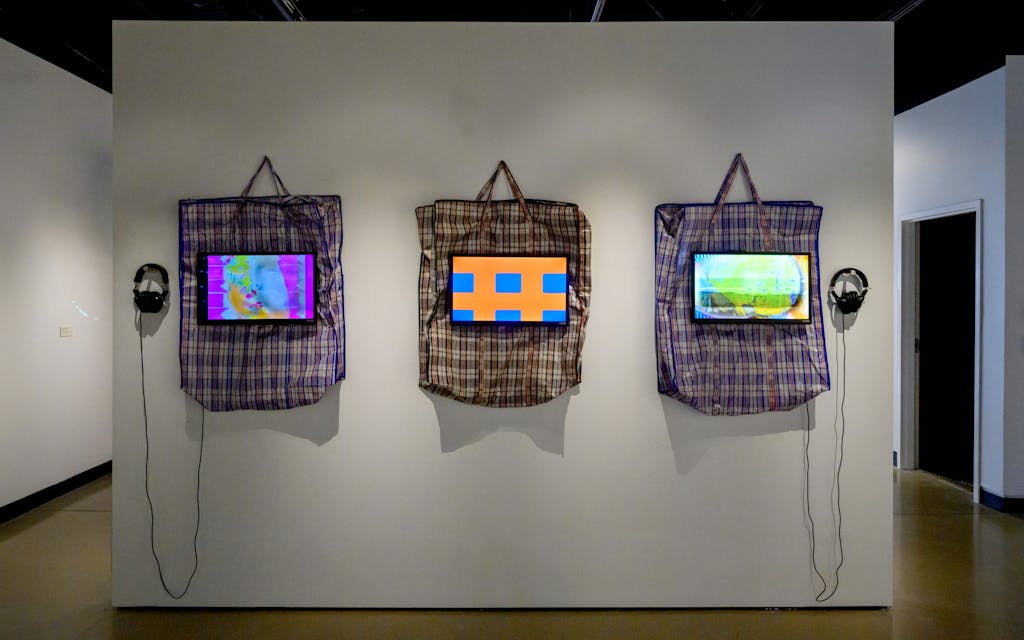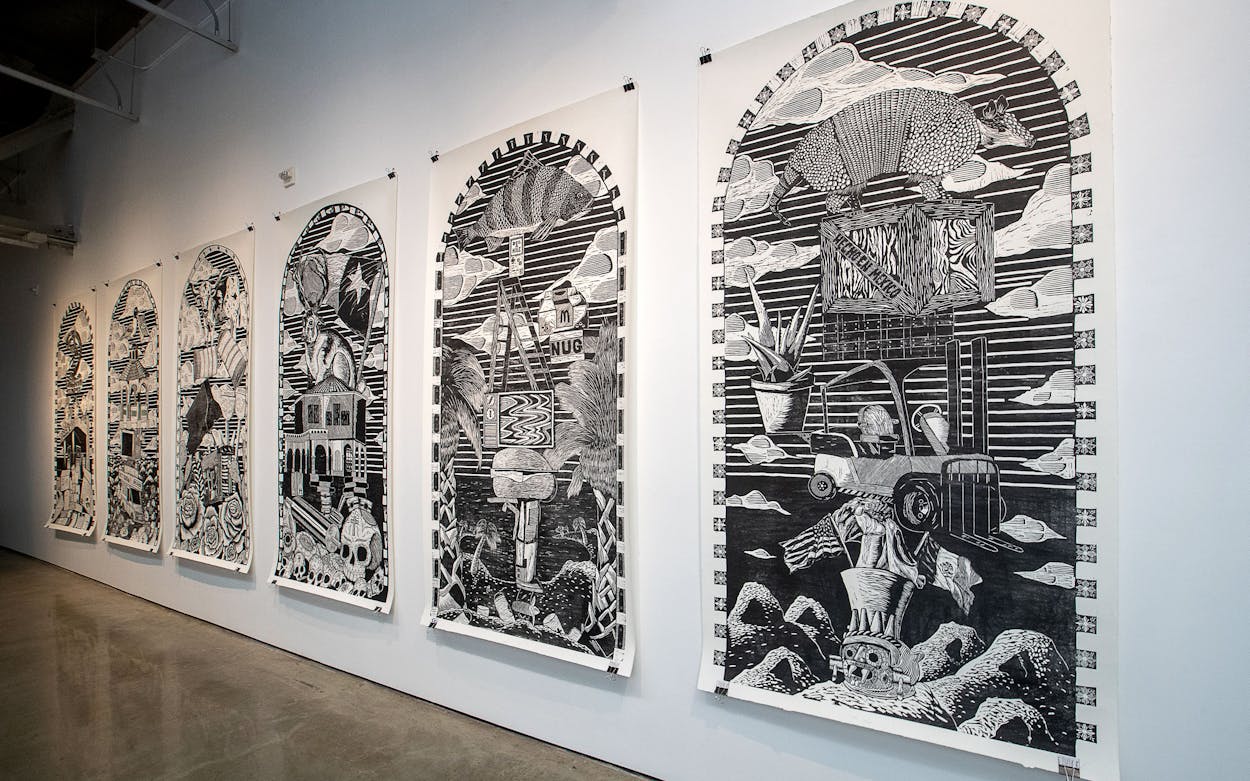Visitors and locals alike flock to San Antonio’s Historic Market Square to get a broad, if perhaps superficial, taste of Texas’s rich Latino heritage: classic Tex-Mex fare, mariachi performers, and knockoff versions of traditional handicrafts. For the next four months, visitors to the odd mixture of living monument and tourist trap will also have the option to engage on more sophisticated terms with the present and future of this huge, diverse, and ever-changing culture, thanks to the savvy exhibition “Soy de Tejas: A Statewide Survey of Latinx Art” at the Centro de Artes Gallery through July 2.
“Soy de Tejas” is the labor of love of a single San Antonio curator, Rigoberto Luna, who is also the proprietor of Presa House Gallery. Luna is a keen observer of the state’s various art scenes, conversant in the value systems of both the status-conscious international art world and the grassroots creative communities of places like Laredo, Corpus Christi, and the Rio Grande Valley, where his gallery has built strong connections. He says he was moved to put on “Soy de Tejas” in part because he noticed several young Texas artists gaining national recognition without proper notice in their home state.
“José Villalobos was a Joan Mitchell grantee. Marianna T. Olague was an Outwin prize finalist. Jenelle Esparza was part of ‘State of the Art’ in Bentonville,” Luna says. “There are a bunch of people doing really incredible things. I just thought they were good representatives of the type of work coming out of Texas right now.”
All three of the artists he mentions are rising talents, and that is, generally speaking, Luna’s focus with “Soy de Tejas.” More-celebrated active Latino artists from Texas, including Vincent Valdez, Alejandro Diaz, Margarita Cabrera, and Dario Robleto, are not on view here. Luna does, however, feature artists who can be seen as occupying the pinnacles of their local scenes, like Cande Aguilar of Brownsville and Gil Rocha of Laredo. These two contribute some of the most powerful work in “Soy de Tejas”—Aguilar a giant, eye-catching canvas in his signature Basquiat-inflected “BarrioPOP” style, and Rocha a trio of funky sculptural works that recall Rauschenberg by way of rasquache (the art-history vocabulary word for cheap, vernacular Chicano DIY).
Other artists on view will be new names to many visitors—younger artists well worth exploring. Stealing the show on the exhibit’s opening day was Untitled (Basket Performance) by Christian Cruz, a live performance Cruz first gave at Dallas’s Nasher Sculpture Center in 2021. In this work, Cruz balances six plastic laundry baskets on her head, while facing a wall, for several strenuous hours. At random intervals, the baskets come crashing down and Cruz stacks them again. She says her aim is to draw attention to unseen labor, especially in museum spaces—for example, the work of the person who cleans the floors—as well as to the monotony of some working-class jobs. The performance, which will be repeated a few times during the “Soy de Tejas” run, by either Cruz or a collaborator, complements three of Cruz’s nearby textile sculptures that address femininity, childbearing, and domestic labor.
Other new-to-me standouts in “Soy de Tejas” include painter Arely Morales of Nacogdoches, who is represented by the estimable Talley Dunn Gallery, in Dallas, and here contributes a sensitive large-scale painting of her father holding a cooler and a plastic bag and standing affably in some sort of garage-office. And there’s Gabriel Martinez of Houston, who works with found, discarded fabrics arranged expressively in abstract wall hangings. Both artists’ works feel rooted in complex street-level realities yet showcase compositional sensibilities that look good on pristine white walls.
Luna says it was not his ambition to make an overarching curatorial argument about any one emerging style, subject matter, or influence shared among the forty artists on display in “Soy de Tejas.” Rather, he says, “the whole show is about balance.” He strove, for example, not to overrepresent San Antonio, where his professional network runs deepest, and to include artists from all cities and corners of the state. He also made sure to include various expressive media, from video art (an installation by Natalia Rocafuerte, who grew up on both sides of the Texas-Tamaulipas border, explores the recollection of dreams in bright, surreal visions reminiscent of pre-internet public access TV) and printmaking (Dallas’s Benjamin Muñoz’s large narrative woodcuts feel epic) to neon (San Antonio’s Ruben Luna, a.k.a. “Gacho Style,” spells out “dreaming” in cursive on the seat of a folding chair) and still photography (San Antonio’s Melissa Gamez-Herrera contributes moving domestic scenes of women workers and labor activists in the Mexican border region).

Also included are voices that complicate the archetypal story of latinidad in Texas, with its usual focus on border and migration concerns. Patrick McGrath Muñiz is a Puerto Rican painter who left the island after losing his home and most of his work to Hurricane Maria in 2017; he contributes hilarious paintings in mock historical style, playing on the familiar image of, for example, George Washington crossing the Delaware with a young woman in a crowded rescue motorboat extending her arm to take a selfie. Chris Marin, another welcome source of comic relief and scrambled identity politics, is a hip-hop-influenced fabric artist straight outta Lubbock who decorates his work with the slogan “Eat Pray Thug” and embroidered rhymes about being broke in the Biden era.
Through all this remarkable diversity, Luna says one of his goals with “Soy de Tejas” was to foster connection across the state between artists who might benefit from a more coherent community. “There are a lot of these artists who don’t even know each other, haven’t met each other at all, and some of them are working kind of similarly,” Luna says. “That was the fun part of the work putting the show together, identifying artists who are working in similar realms.”


As I chatted with Cande Aguilar at the opening, he remarked to me that it felt like just a matter of time until one of these artists would break through and attract the eyes of the national art world to what has been building in Texas. Who might that be? The best bets are perhaps the three critically lauded artists Luna mentioned—Villalobos, from El Paso and based in San Antonio, with his impeccable sculptural works on machismo, sexuality, and the trappings of norteño cowboy culture; Esparza, with her delicate attention to materials linked to her family’s history in South Texas cotton farming; and Olague, with her finely detailed, painterly observations of her El Paso hometown.
But Luna’s curation of “Soy de Tejas” doesn’t feel focused on the question of which artists on view will rise highest in the world of valuations and gallery shows. Instead, the prevalent ethos is summed up in a title of a work by Dallas’s Tina Medina: They Didn’t Know We Were Seeds. Medina, who works with both American and Mexican flags in her art, here layers cuttings of the two flags in a tree design over the body of a small Hispanic child pictured with his parents in a black and white photograph. Hung at the entrance to the exhibition, the piece underlines what a rich harvest this show is, and what abundance these artists promise for the coming decades of Texas art.
- More About:
- Art
- San Antonio






